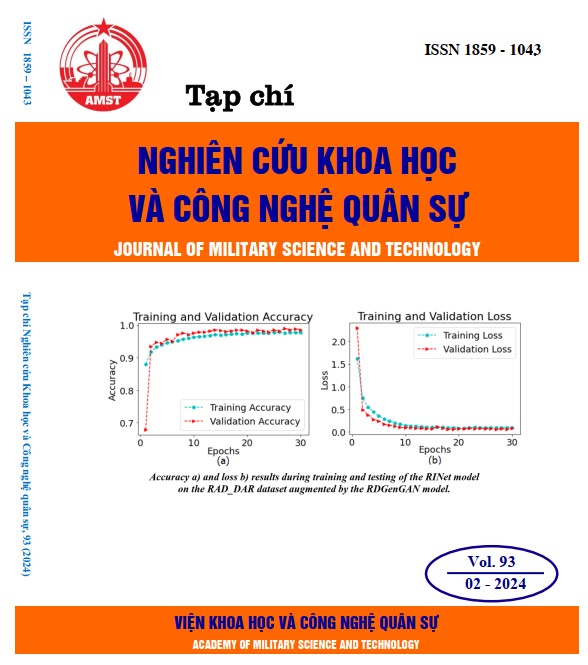Improving radar target recognition based on generative adversarial network
509 viewsDOI:
https://doi.org/10.54939/1859-1043.j.mst.93.2024.12-18Keywords:
Radar dataset; Radar Target Recognition; GAN; Deep Learning; Data AugmentationAbstract
In this article, we propose a generative model based on the adversarial network structure to enhance images for the RAD-DAR multi-target dataset. The results of comparisons and evaluations indicate that the images generated by the proposed method exhibit a high degree of similarity to the original images. The experimental process also demonstrates that a deep neural network model trained on the augmented dataset achieves higher accuracy in multi-target recognition compared to a model trained on the original dataset. The proposed data generation model serves as an effective solution to address the data scarcity issue in multi-target datasets.
References
[1]. Marcio L. Lima de Oliveira and Marco J. G. Bekooij. “Generating Synthetic Short-Range FMCW RangeDoppler Maps Using Generative Adversarial Networks and Deep Convolutional Autoencoders”. In: 2020 IEEE Radar Conference (RadarConf20). pp. 1–6, (2020). DOI: 10.1109/RadarConf 2043947.2020.9266348. DOI: https://doi.org/10.1109/RadarConf2043947.2020.9266348
[2]. Arthur Ouaknine, Alasdair Newson, Julien Rebuty, Florence Tupin and Patrick Perez. “CARRADA Dataset: Camera and Automotive Radar with Range-Angle-Doppler Annotations”. 2020 25th International Conference on Pattern Recognition (ICPR) Milan, Italy, Jan 10-15, (2021). DOI: https://doi.org/10.1109/ICPR48806.2021.9413181
[3]. Yizhou Wang, Zhongyu JiangYudong Li, Jenq-Neng Hwang “RODNet: A Real-Time Radar Object Detection Network Cross-Supervised by Camera-Radar Fused Object 3D Localization”. arXiv:2102.05150v1 [cs.CV] (2021). DOI: https://doi.org/10.1109/JSTSP.2021.3058895
[4]. Xiangyu Gao, Guanbin Xing, Sumit Roy, and Hui Liu “RAMP-CNN: A Novel Neural Network for Enhanced Automotive Radar Object Recognition”. arXiv technical report (arXiv 2011.08981).
[5]. Ali, S., Ghatwary, N., Braden, B., Lamarque, D., Bailey, A., Realdon, S., Cannizzaro, R., Rittscher, J., Daul, C., & East, J., “Endoscopy disease detection challenge 2020”. ArXiv Preprint ArXiv:2003.03376, (2020).
[6]. Hidetoshi Furukawa “Deep Learning for Target Classification from SAR Imagery: Data Augmentation and Translation Invariance”. arXiv:1708.07920.
[7]. Marcel Sheeny , Andrew Wallace and Sen Wang “RADIO: Parameterized Generative Radar Data Augmentation for Small Datasets”. Appl. Sci., 10, 3861, (2020); doi:10.3390. DOI: https://doi.org/10.3390/app10113861
[8]. Goodfellow, I., Pouget-Abadie, J., Mirza, M., Xu, B., Warde-Farley, D., Ozair, S., Courville, A., & Bengio, Y., “Generative adversarial nets”. Advances in Neural Information Processing Systems, 27, (2014).
[9]. Ibrahim Alnujaim, Youngwook Kim “Augmentation of Doppler Radar Data Using Generative Adversarial Network for Human Motion Analysis”. Healthc Inform Res; 25(4):344-349, pISSN 2093-3681, eISSN 2093-369X, (2019). DOI: https://doi.org/10.4258/hir.2019.25.4.344
[10]. Thomas Truong, Svetlana Yanushkevich, “Generative Adversarial Network for Radar Signal Generation”. arXiv:2008.03346v1 [eess.IV], (2020). DOI: https://doi.org/10.1109/IJCNN.2019.8851887
[11]. R. C. Tewari, P. Palo, J. Maiti and A. Routray, “GAN-based Radar Micro-Doppler Augmentation for High Accuracy Fall Detection System,” IECON 2022 – 48th Annual Conference of the IEEE Industrial Electronics Society, Brussels, Belgium, pp. 1-6, (2022), doi:10.1109/IECON49645.2022.9968957. DOI: https://doi.org/10.1109/IECON49645.2022.9968957
[12]. G. Huang, Y. Yuan, Q. Xu, C. Guo, Y. Sun, F. Wu, K. Weinberger, “An empirical study on evaluation metrics of generative adversarial networks”, International Conference on Learning RepresentationsRejected. URL https://openreview.net/forum?id=Sy1f0e-R-
[13]. Eduardo C. Fidelis, Fabio Reway, Herick Y. S. Ribeiro, Pietro L. Campos, Werner Huber Christian Icking, Lester A. Faria, Torsten Schon. “Generation of Realistic Synthetic Raw Radar Data for Automated Driving Applications using Generative Adversarial Networks”. arXiv:2308.02632v2 [cs.CV], (2023).
[14]. Nguyễn Văn Trà, Vũ Chí Thanh, Đoàn Văn Sáng, “Giải pháp nâng cao xác suất nhận dạng đúng mục tiêu UAV ứng dụng trí tuệ nhân tạo”, Tạp chí Khoa học và Công nghệ quân sự, số Đặc san FEE, (2023). DOI: https://doi.org/10.54939/1859-1043.j.mst.FEE.2023.105-110







